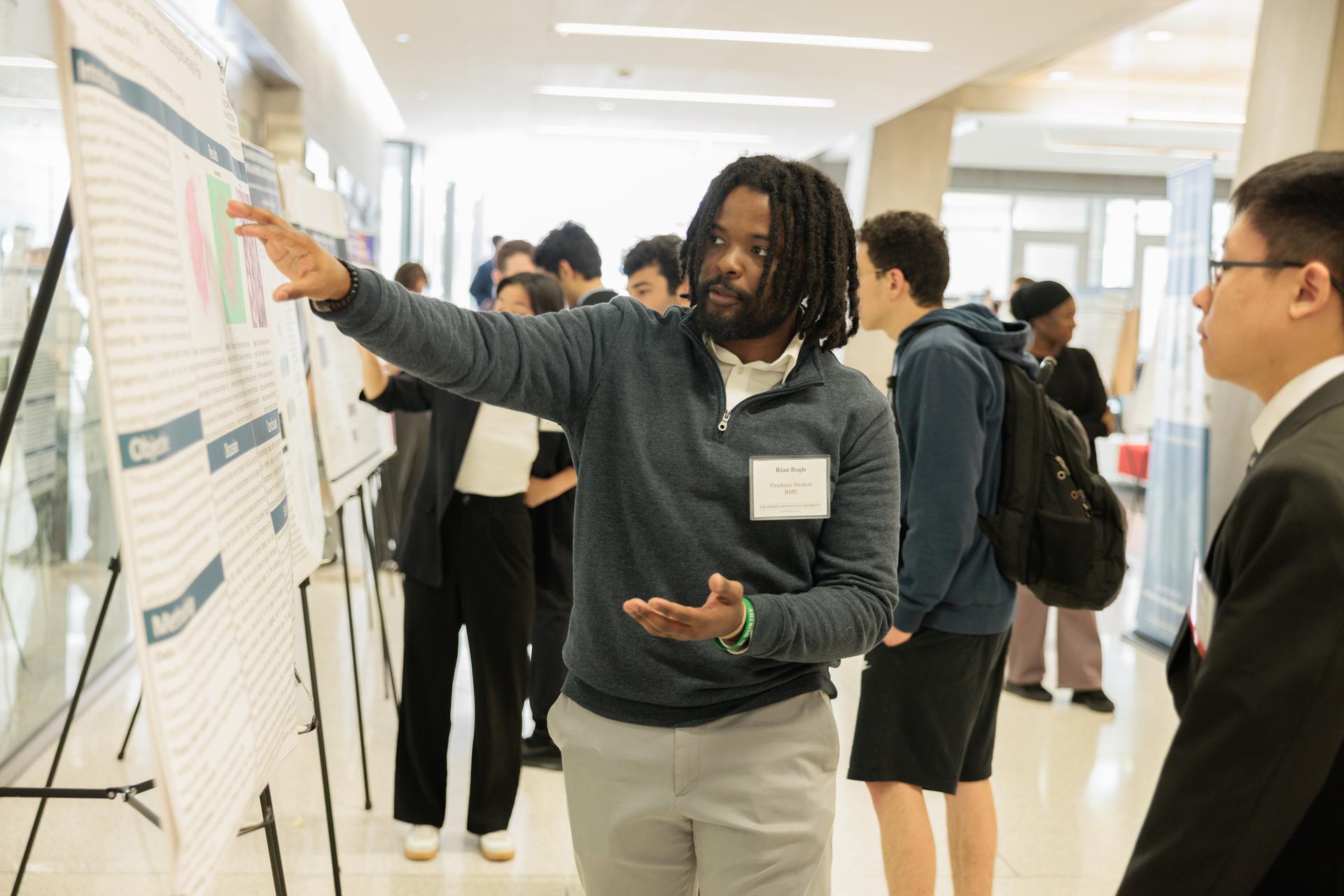On the sixth floor of the George Washington University Science and Engineering Hall, Arnaud Martin’s laboratory holds a hidden treasure trove: hundreds of butterfly specimens whose wings, under Martin’s microscopes, glow rich orange, jeweled blue and dusty white. Martin, an assistant professor of biology at the Columbian College of Arts and Sciences who studies the effect of butterflies’ and moths’ genetic code on their wing coloration, was one of several GW researchers to open their laboratories for public tours at the GW Research Showcase Wednesday.
Organized by the Office of the Vice Provost for Research (OVPR), the showcase also featured presentations by GW research institutes, informational tabling by research-related initiatives and offices, a faculty book display and poster sessions by about 50 undergraduate, graduate and postdoctoral student researchers across the university. The event was open to the entire campus community and guests included alumni, employer partners, external collaborators and the public. The GW Research Showcase capped off a month of school- and department-led research symposia across the university.
“As a leading comprehensive research university, one of our defining strengths is that scholars from the arts, humanities, social sciences, health and STEM fields can collaborate to tackle some of the biggest challenges—challenges like climate change, like racial and socio-economic disparities, like diversifying our STEM workforce, like the impact of rapidly evolving technologies that will touch every aspect of our lives,” Vice Provost for Research Pamela Norris said. “The posters and presentations on display here are only a fraction of the scholarly activity across the campus.”
The showcase theme, “GW Research for a Sustainable and Equitable Future,” extended to a range of disciplines and research areas. Work on display also spanned the globe, from accelerated melting cycles in the Arctic permafrost to oral health in Northern Kenya. Several projects were rooted in GW’s home community of Washington, D.C., including an environmental justice-focused proposal for achieving equity in the city’s Lead Free DC initiative; a study of dietary habits among uninsured D.C. residents; and an investigation into community awareness of acoustic gunshot detection systems.
Presenter Lily Shan, a senior in the Elliott School of International Affairs, investigated the friction between initiatives for gender equality and sustainability in India, where students are provided with free menstrual products to combat the country’s ongoing educational gender gap and high female dropout rate. Unfortunately, these products also are a source of plastic waste that can take up to 800 years to degrade.
Shan interviewed dozens of female students in the Tamil Nadu city of Coimbatore and found indications that some potential solutions are outweighed by their safety and comfort drawbacks: some schools have installed personal-use incinerators, for instance, which Shan’s interviewees said regularly malfunction or flood the bathroom with smoke. But others might find unexpected acceptance: Her interviewees were generally open to the possibility of using reusable menstrual cups, despite cultural taboos around their use.
Shan said she was led to the research in part by family history. Her grandmother struggled to complete her own education in the same part of India, earning her GED only after she emigrated to the United States.
“Growing up I've always heard stories from my grandmother regarding how hard it was to get the reproductive health care that she needed, and she recalled trying to navigate this issue of managing her period while also going to school,” Shan said. “At that point in time people weren't necessarily thinking about sustainability. But my family is also from the farming caste in India, so they were constantly thinking in connection to their environmental impact. I really wanted to explore that intersection of gender equality and sustainability.”
Presenter Ryan Antar, a third-year medical student at the School of Medicine and Health Sciences, analyzed data from the National Cancer Database to study the effect of income disparity on bladder cancer treatment. He found that low-income patients—regardless of other linked factors like insurance status, comorbidity status, age, gender or race—had worse survival outcomes and were less likely to receive certain types of high-standard, guideline-based care, including pre-operative chemotherapy and sufficient pelvic lymph node removal during surgery. Antar said the research provides a basis for more detailed analysis in the pursuit of improved equity of care.
“More research should be done into why income in particular, in the schema of socioeconomic status, is causing this,” he said. “Guideline-based care is what everyone should be getting, and the fact that these patients are not getting it—beyond ineligibility for other reasons—is really compelling.”
The showcase ended with presentations by three winners of this year’s Three-Minute Thesis Competition and a pitch from GW Ph.D. student Lingchen Kong, cofounder with Assistant Professor of Civil and Environmental Engineering Xitong Liu of chemical-free lithium extraction company Ellexco.



